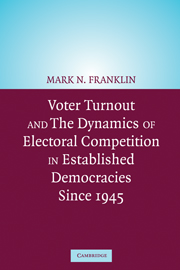The time has come to put what we have learned into a model that attempts to explain turnout change over the longest possible period for the largest possible number of countries. Twenty-two countries have a record of elections held continuously since within one electoral cycle (generally four years) of the end of World War II, amounting to 356 elections in all. We need to study elections held continuously because, if any elections are missing, we can investigate neither cumulative effects nor influences like the habit of voting that are coded with reference to past elections. Many countries that started holding elections shortly after World War II do not meet the criterion of continuous elections. If we attempt to increase the number of countries beyond twenty-two, we dramatically shorten the total period over which we can make the comparisons. At the same time, the period cannot be extended to include years before World War II because so many countries had at least two electoral cycles without elections before and during that singular cataclysm (Austria, Britain, France, Germany, Italy, Japan, Luxembourg, The Netherlands, and Norway) or did not exist (Israel). The countries we can study from 1945 onward include those ten and also Australia, Belgium, Canada, Denmark, Finland, Iceland, Ireland, Malta, New Zealand, Sweden, Switzerland, and the United States. The period of our study ends in 1999 because data for some variables are hard to find for elections more recent than that.

